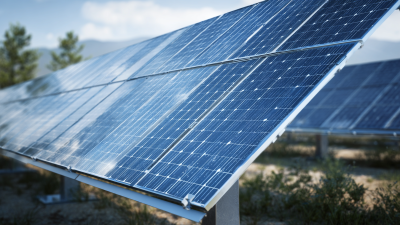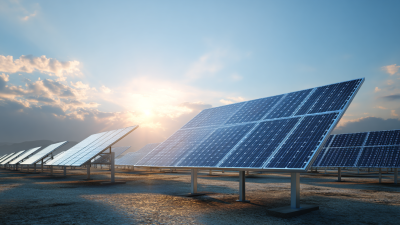How to Choose the Best Solar Solutions for Your Business Needs
As businesses increasingly prioritize sustainability, the demand for effective solar solutions has surged. According to the International Renewable Energy Agency (IRENA), global solar energy capacity reached over 710 gigawatts in 2019, and is projected to continue growing rapidly. A report from the Solar Energy Industries Association (SEIA) indicates that solar adoption among U.S. businesses has doubled in recent years, highlighting the technology's capacity to significantly reduce operational costs and carbon footprints.

However, with a plethora of options available, choosing the right solar solutions tailored to specific business needs can be a daunting task. This blog aims to provide valuable insights and tips for businesses looking to navigate the complexities of solar investments, ensuring that they make informed decisions that align with their operational goals and sustainability targets.
Understanding Your Energy Consumption Patterns for Solar Solutions
 Understanding your energy consumption patterns is essential in selecting the best solar solutions for your business. Analyzing your previous utility bills can give you insights into peak consumption times and the total energy used throughout different seasons. According to the U.S. Energy Information Administration, commercial buildings consume on average 12.8 kilowatt-hours (kWh) per square foot annually. By identifying high-energy usage periods, businesses can optimize their solar investments to ensure optimal installation and peak capture of solar energy.
Understanding your energy consumption patterns is essential in selecting the best solar solutions for your business. Analyzing your previous utility bills can give you insights into peak consumption times and the total energy used throughout different seasons. According to the U.S. Energy Information Administration, commercial buildings consume on average 12.8 kilowatt-hours (kWh) per square foot annually. By identifying high-energy usage periods, businesses can optimize their solar investments to ensure optimal installation and peak capture of solar energy.
Tip: Conduct an energy audit to assess your consumption. This audit should include evaluating machinery, HVAC systems, and lighting. Understanding which areas consume the most energy will help you design a solar solution that effectively meets your specific needs.
In addition to past consumption, it’s important to consider future energy demands. Many businesses are expanding, and forecasting future consumption can significantly affect the size and type of solar system needed. A Solar Energy Industries Association (SEIA) report indicates that solar installations in commercial settings can reduce electric bills by 60% or more. Therefore, planning for growth will ensure your solar system supports increased energy needs without requiring expensive upgrades later.
Tip: Consult with a solar energy expert to project future energy needs accurately. They can provide insight into how solar technology can grow alongside your business.
Evaluating Different Types of Solar Technologies Available for Businesses
When evaluating different types of solar technologies available for businesses, it's essential to understand the unique advantages each option offers. Solar photovoltaic (PV) systems are a popular choice, converting sunlight directly into electricity, making them suitable for businesses with significant energy consumption. Additionally, solar thermal solutions can provide hot water for various applications, particularly in industries like hospitality and manufacturing.
Tip: Assess your energy needs and consider how much roof space or property area is available before making a decision. This can help streamline the selection process and ensure that the chosen technology aligns with your facility's energy profile.
Another compelling option is the integration of solar battery storage systems. These systems allow businesses to store excess energy generated during peak sunlight hours for use during non-peak times, enhancing energy independence and lowering utility costs. This is especially beneficial for companies that operate outside of traditional business hours.
Tip: Look into federal and state incentives as well as financing options that can help offset initial installation costs. Leveraging these financial aids could make the transition to solar energy more feasible and attractive for your business.
Assessing the Financial Impact: ROI and Cost Savings from Solar Investments
When considering solar solutions for your business, it’s crucial to assess the financial impact these investments will have on your bottom line. A key metric to evaluate is the Return on Investment (ROI). By analyzing the initial installation costs and expected energy savings over time, businesses can gain insight into how quickly they might recoup their investment. Typically, commercial solar systems can yield an ROI ranging from 10% to 30% within the first few years, depending on factors like location, energy usage, and available incentives.
In addition to ROI, potential cost savings play a significant role in decision-making. Solar energy can drastically reduce monthly utility bills, leading to substantial savings over the lifespan of the system, often exceeding 20 years. Additionally, many regions offer tax credits and rebates that can offset upfront costs, enhancing the overall financial appeal. Moreover, as energy prices continue to rise, businesses harnessing solar power can hedge against future rate increases, thereby securing predictable energy expenses and further bolstering their financial resilience.
How to Choose the Best Solar Solutions for Your Business Needs - Assessing the Financial Impact: ROI and Cost Savings from Solar Investments
| Business Size | Annual Energy Consumption (kWh) | Estimated Solar Panel Cost ($) | Annual Savings from Solar ($) | ROI (% over 20 years) | Payback Period (Years) |
|---|---|---|---|---|---|
| Small Business | 20,000 | 15,000 | 2,500 | 13% | 6 |
| Medium Business | 50,000 | 40,000 | 7,500 | 18% | 5.3 |
| Large Business | 200,000 | 150,000 | 20,000 | 22% | 7.5 |
| Enterprise | 500,000 | 400,000 | 90,000 | 25% | 4.4 |
Navigating Incentives and Rebates: Maximizing Your Solar Project Budget
Navigating the landscape of solar incentives and rebates can significantly enhance your business's solar project budget. According to the Solar Energy Industries Association (SEIA), as of 2023, the federal solar tax credit (ITC) allows businesses to deduct 26% of solar installation costs from their federal taxes, a substantial benefit for capital-intensive projects. Additionally, numerous states offer their own incentives, such as performance-based incentives (PBIs) and rebates, which can lower the upfront costs further.
Furthermore, businesses should be aware of local utility programs that promote solar energy adoption. For instance, many utilities provide additional rebates or even bill credits for solar energy production, which can increase the financial viability of a solar project. A report by the National Renewable Energy Laboratory (NREL) indicates that businesses leveraging these incentives can see an average payback period of around five to seven years on their investment, making solar not only a sustainable choice but also a financially sound one. Maximizing these incentives is crucial for optimizing your return on investment and achieving long-term savings.
Choosing the Right Solar Installer: Key Qualifications and Certifications to Look For
When choosing the right solar installer for your business, it's crucial to consider specific qualifications and certifications that ensure quality and reliability. Look for installers who are accredited by recognized solar industry organizations, such as the Clean Energy Council in Australia, which sets stringent guidelines for installers. According to the Australian Renewable Energy Agency (ARENA), using a certified installer can significantly increase the efficiency and performance of a solar panel system, leading to a more favorable return on investment.

Additionally, consider the installer’s experience and customer reviews. Reports indicate that businesses that engage experienced installers often achieve better project outcomes and fewer maintenance issues. The Solar Energy Industries Association (SEIA) notes that customer satisfaction is highest among those who choose seasoned professionals with a proven track record. Finally, verify that the installer offers comprehensive warranties that cover both equipment and workmanship, as this can protect your investment and ensure peace of mind for years to come.
Related Posts
-

10 Proven Tips to Maximize Solar Potential for Your Business
-

Unlocking the Specifications of the Best Solar Solutions for Global Buyers
-

Harnessing 2025 Trends in Solar Technology to Choose the Best Solar Panels for Your Energy Needs
-

5 Essential Tips for Buyers to Maximize Benefits of Solar Hot Water Systems
-

What is a Solar Absorber and How Does It Enhance Energy Efficiency
-

Unlocking Efficiency: The Economic Advantages of Hot Water Solar Systems for Sustainable Living
